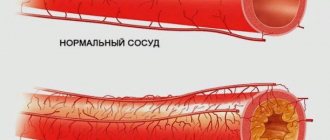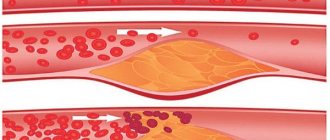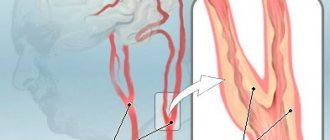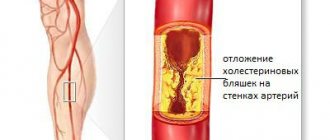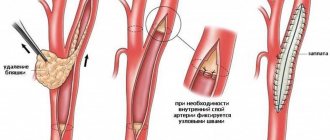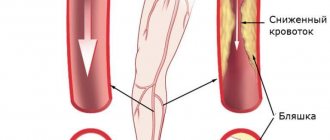The aorta is the largest artery of the human body. Through it, blood flows to all organs. The part that passes through the abdomen is called the abdominal aorta. Atherosclerosis of the abdominal aorta is a disease characterized by the formation of plaque on the wall of this blood vessel.
Since the lesions affect the epigastric region, the pathology is characterized by impaired functioning of the gastrointestinal tract (gastrointestinal tract). This occurs as a result of insufficient supply of oxygen and nutrients to these organs. Most often, men over 40 years of age and women after they reach 55 years of age are affected.
Causes
Lipid metabolism disorders are the main cause of the development of atherosclerosis of the aorta in the abdominal cavity. This process leads to an increase in cholesterol levels in the blood, resulting in the formation of plaques on the inner wall of the vessel.
The following factors contribute to this pathological process:
- abuse of high-fat foods;
- insufficient amount of fiber in the diet;
- infectious diseases;
- diseases of the thyroid and pancreas;
- lack of physical activity;
- intoxication with chemicals;
- complicated heredity, when a close relative suffered from the same disease;
- smoking and addiction to alcohol;
- hypertonic disease.
As a person ages, the risk of developing atherosclerotic changes in blood vessels increases. Most often this pathology occurs in men. But after 55 years, the risk of developing atherosclerosis in both sexes is equal. Because of this, men, upon reaching 45 years of age, are recommended to undergo regular tests to determine their lipid profile.
For women, such a study should be systematically carried out after 55 years. Immediately after detection of violations it is necessary to begin treatment. Normally, human blood contains high and low density lipoproteins, but the former should predominate. With the development of atherosclerosis, low-density lipoproteins increase, and they settle on the inner wall of blood vessels.
No ads 1
An atherosclerotic plaque gradually forms from them. Increasing in size, they reduce and sometimes even block the lumen of the vessel. This, in turn, creates an obstacle to the normal movement of blood in the aorta, and the organs that feed from it begin to experience nutritional deficiencies. This is what causes the development of pathological symptoms.
Low-density lipoproteins cause the formation of atherosclerotic plaque on blood vessels
Methods for diagnosing atherosclerosis
Starting from the age of 45, it is advisable to undergo annual preventive examinations, especially for men.
Laboratory and instrumental studies are used to diagnose atherosclerosis.
The earlier the disease is detected, the lower the risk of complications. Effective treatment can slow down the development of atherosclerosis and improve the patient's condition. To undergo an initial examination, you can contact, first of all, a general practitioner (general practitioner or family doctor), as well as a cardiologist (if you are worried about your heart) or a neurologist (if you have neurological symptoms - memory impairment, dizziness, decreased attention, sleep disorders ).
Laboratory diagnostics
"Family Doctor" offers to use the laboratory profile "Diagnostics of atherosclerosis", which includes the necessary types of tests.
ECG
In the diagnosis of atherosclerosis, ECG is used in conjunction with other instrumental studies. As a basic cardiac procedure, the ECG usually precedes other diagnostic tests.
More information about the diagnostic method
Echocardiography
Echocardiography is an informative method of instrumental examination of the heart and coronary vessels using ultrasound. Echocardiography (Echo CG) makes it possible to assess in real time the nature of damage to the walls of the coronary vessels, the presence of blood clots in them, as well as the speed of blood flow. Used to diagnose atherosclerosis of the coronary vessels.
More information about the diagnostic method
Ultrasound Dopplerography of blood vessels
Ultrasound Dopplerography of vessels allows you to determine their diameter, wall thickness, identify intraluminal formations (atherosclerotic plaques, blood clots), assess the condition of venous valves, and detect blood flow disorders. Depending on the situation, ultrasound examination of vessels of various locations (cerebral vessels, brachiocephalic arteries, vessels of the lower or upper extremities, renal arteries) is performed.
Angiography
The essence of the angiography method is that a radiopaque substance is injected into the circulatory system, which makes it possible to visualize blood flow in problem vessels.
To diagnose the condition of the heart, aorta and its large branches, radiography, computed tomography and MRI examination of the chest organs can be used.
Sign up for diagnostics To accurately diagnose the disease, make an appointment with specialists from the Family Doctor network.
Manifestations
There are several stages of the disease, which differ in the degree of damage to the aorta. The initial stage has no clinical manifestations, and atherosclerotic plaques can only be identified by performing a computed tomography scan of the abdominal cavity. The condition of the inner wall of the aorta is gradually deteriorating, which is expressed in the following symptoms:
- heaviness and discomfort in the abdominal area;
- aching night pains that occur after eating and radiate to the groin and lower back;
- indigestion;
- unstable stool;
- the occurrence of heartburn and nausea after eating;
- pulsation and tension in the navel area on the left side.
In the absence of timely treatment, the kidneys are involved in the pathological process. In the patient, this is expressed in difficulty urinating, swelling of the limbs and face, as well as pain in the lumbar region. If atherosclerotic lesions of the aorta occur in the area of its division into the iliac arteries, circulatory disturbances occur in the lower extremities.
In this case, the following symptoms are possible:
- swelling of the legs;
- erectile dysfunction;
- ulcerative formations on the skin of the legs;
- decreased muscle tone;
- loss of pulsation in the feet;
- numbness and cold feet.
No ads 2
As a result of thrombosis of the visceral arteries, which arise from the aorta and nourish the internal organs, the patient experiences intense pain in the abdominal area. This symptom is caused by the death of intestinal cells. In addition, intestinal motility is disrupted, the patient complains of attacks of nausea and vomiting, increased body temperature, constipation followed by diarrhea.
All this interferes with a person’s ability to work. As a result of thrombosis, peritonitis can develop, and this is a life-threatening condition. Atherosclerosis of the abdominal aorta is characterized by the development of abdominal ischemic syndrome. It, in turn, is manifested by the following triad: abdominal pain, intestinal dysfunction, weight loss with adequate nutrition.
Symptoms of atherosclerosis of the abdominal aorta are classified according to the clinical manifestations of the disease into 3 types: abdominal form, dysfunction of the small and large intestines. In the first case, the liver, part of the duodenum and pancreas are affected. The disorders manifest themselves mainly as pain in the abdominal region.
If the branches of the aorta that supply the small intestine are affected, the patient experiences impaired motility, intestinal obstruction may develop, flatulence appears, and rectal bleeding is possible. With atherosclerosis of the branches responsible for the functioning of the colon, a person experiences bloating, ulcers form on the mucous membrane and bleeding from the rectum.
Abdominal pain is one of the main symptoms of atherosclerosis of the abdominal aorta
Diagnostics
To identify atherosclerosis of the abdominal aorta, a number of examinations are performed. Among the instrumental diagnostic methods there are:
- electrocardiogram;
- rheoencephalography;
- ultrasound examination of the abdominal cavity;
- angiography;
- fluorogram;
- duplex or triplex scanning.
All these diagnostic methods make it possible to determine the state of blood flow from the aorta to the organs. At the initial appointment, the doctor collects anamnesis and examines the patient. Blood is donated to determine cholesterol levels. If the initial stage of atherosclerosis is suspected, the following methods are additionally used:
- sphygmogram (pulse fluctuations in the artery are determined);
- electrokymogram (vessel density is determined);
- ballistocardiogram (the contractile function of the myocardium is studied).
Causes of acute intestinal ischemia
- Atherosclerosis of the intestinal arteries can lead to their thrombosis with the subsequent development of mesenteric ischemia. If there are signs of coronary heart disease, atherosclerotic lesions of the arteries of the legs in a patient, systemic atherosclerosis can be implied and, accordingly, the risk of abdominal ischemia can be taken into account.
- High or low blood pressure increases the risk of mesenteric thrombosis and intestinal ischemia
- Heart failure and atrial fibrillation increase the risk of intestinal arterial embolism (transfer of a blood clot from the heart to the arteries) and acute intestinal ischemia.
- Increased blood clotting in thrombophilia, sickle cell anemia and antiphospholipid syndrome.
- Cocaine and methamphetamine use can cause intestinal vasospasm and intestinal ischemia.
Treatment and prevention
Atherosclerosis of the abdominal aorta is one of those types of diseases that cannot be completely eliminated. Therefore, it must be treated for the rest of its life. Elimination of symptoms is an important part of therapy, but the main effort must be given to the cause of its occurrence. This is a reduction in cholesterol levels in the blood and restoration of blood flow to the organs. When the level of low-density lipoproteins is normalized, the manifestations of the disease will be less intense.
In the treatment of atherosclerosis, crucial importance is given to rational nutrition and maintaining a healthy lifestyle. In particular, it is recommended to avoid stress and excessive physical activity, since they often cause fluctuations in blood pressure, which is undesirable in case of atherosclerosis.
The patient must change his diet, completely eliminating animal fats, light carbohydrates, alcohol and refined foods. This measure will slow down the rate of development of atherosclerotic plaques. Giving up bad habits will preserve the strength of the vascular wall. Drug therapy should be combined with a diet aimed at reducing blood cholesterol.
The main treatment includes taking medications that are aimed at the following:
- lowering cholesterol levels (Simvastatin, Cholestyramine, Lovastatin, Clofibrate);
- improvement of blood circulation (Pentoxifylline, Actovegin, Cardiomagnyl, Clopidogrel).
In some situations, patients with atherosclerosis require surgical intervention. This happens when the symptoms of the pathology significantly impair the patient’s quality of life. Nevertheless, surgical methods are unable to completely eliminate the cause of atherosclerosis, but will help to significantly reduce its consequences. In the practice of surgical treatment of atherosclerosis, 3 types of operations are used:
- Endarterectomy. Removal of plaque through an open longitudinal incision in the vessel.
- Shunting. An additional way is being created to ensure the movement of blood bypassing the affected vessel, the lumen of which is blocked by plaques. With the help of a shunt, healthy sections of blood vessels are connected and a new trajectory of blood movement is created.
- Angioplasty. The atherosclerotic vessel is expanded using a special balloon inserted through a catheter.
No ads 3
Against the background of treatment using traditional medicine, you can also use folk remedies. They will help strengthen and restore blood vessels, and some can remove excess cholesterol from the blood. Recipes are recommended that contain the following components or a combination of them: thyme, garlic, hawthorn, dandelion roots.
Folk remedies cannot completely replace pharmaceutical drugs for the treatment of the disease in question. Therefore, their combination will be more effective.
To prevent atherosclerosis, it is recommended to adhere to the following rules:
- weight loss if you have extra pounds;
- balanced diet;
- timely treatment of diseases associated with the functioning of the pancreas and thyroid gland;
- complete cessation of smoking.
Vascular surgery will prevent the development of severe complications of atherosclerosis
How is atherosclerosis treated, what options exist?
For atherosclerosis, treatment is carried out comprehensively. A person must adhere to a diet. The diet is drawn up by a doctor, limiting fatty foods (primarily animal fats), simple carbohydrates and salt, and the person must also give up bad habits - smoking and drinking alcohol, and perform light physical activity (therapeutic exercises). In addition, the patient begins taking a course of medications, the task of which is to remove excess cholesterol from the human body, as well as aimed at reducing the activity of the body’s “production” function of cholesterol. If the above steps do not work, as well as in the case of a high probability of arterial blockage, then the patient is prescribed surgical intervention.
Unfortunately, atherosclerosis is an irreversible disease and it is completely impossible to cure it.
Complications and prognosis
With late detection of atherosclerosis of the abdominal aorta, complications develop that worsen the patient's condition. Necrotic processes may begin in the intestines, which leads to the development of peritonitis. With thrombosis of its branches, the rate of spread of necrosis and inflammation increases. A typical complication of atherosclerosis of the abdominal aorta is renal failure.
The main complications appear gradually. First, ischemia develops, which manifests itself in the appearance of chromate, abdominal pain, and angina attacks. Since the lack of blood supply is not constant and is periodic, complications develop in fewer numbers. The next stage is thromonecrotic. It is characterized by the fact that the atherosclerotic process becomes chronic.
More complications occur, mainly as a result of thrombosis. Most often it is a heart attack, gangrene of the lower extremities, or stroke. The next stage of complications is associated with the fibrotic stage of the disease - cardiosclerosis as a result of the replacement of muscle tissue with fibrous tissue. One of the common consequences of this pathology is an aneurysm.
The gradual accumulation of plaques in one area of the vessel and its further bulging thin and weaken the vascular wall. A rupture can happen at any time, and the probability of death in this case is 90%. The prognosis for a patient's life with atherosclerosis of the abdominal aorta cannot be accurately determined.
It depends on many individual factors and characteristics of the course of the disease. Maintaining ability to work is determined by the severity of the stage of atherosclerosis. Timely comprehensive treatment, combining medications and changes in lifestyle and nutrition, can significantly reduce the risk of death from atherosclerosis.
Symptoms of atherosclerosis
The first period of atherosclerosis is the preclinical (asymptomatic) period. During this period, the disease does not make itself known in any way, while a high (exceeding the norm) amount of β-lipoproteins or cholesterol is detected in the human blood. Clinical manifestations occur only after the vessel becomes 50% narrower (or more). The symptoms of this disease depend on which artery or aorta is affected.
Atherosclerosis of cerebral vessels.
Symptoms:
deteriorated memory function, low poor performance, sleep problems, dizziness. As it progresses, the patient’s psyche becomes impaired. The following complications may also make themselves felt: thrombosis and hemorrhage.
Atherosclerosis of the heart vessels (coronary vessels).
Symptoms:
myocardial infarction, cardiosclerosis, angina pectoris.
Atherosclerosis of the thoracic aorta.
Symptoms:
severe pain behind the sternum, radiating to the upper abdomen or back and arm. Duration: the continuation of such pain occurs from a couple of hours and even up to several days.
Atherosclerosis of the abdominal aorta.
Symptoms:
constipation, flatulence, pain in the abdominal area; in addition, numbness of the legs and swelling of the feet may occur.
Atherosclerosis of the renal arteries.
Symptoms:
unilateral damage - gradual development and intensification of hypertension with constantly high blood pressure numbers; bilateral damage - arterial hypertension. Low back pain may also be present.
Atherosclerosis of the arteries of the lower extremities.
Symptoms:
pain in the calves or a feeling of weakness in them, a feeling of numbness in the legs.
Atherosclerosis of the penile arteries.
Symptoms:
erection problems, impotence.
